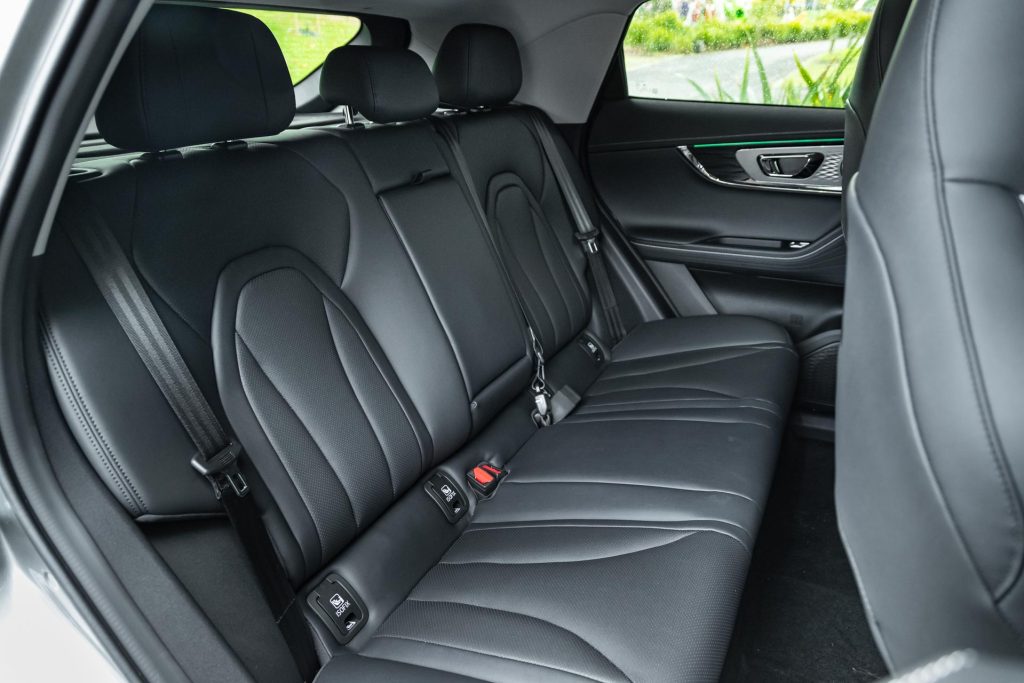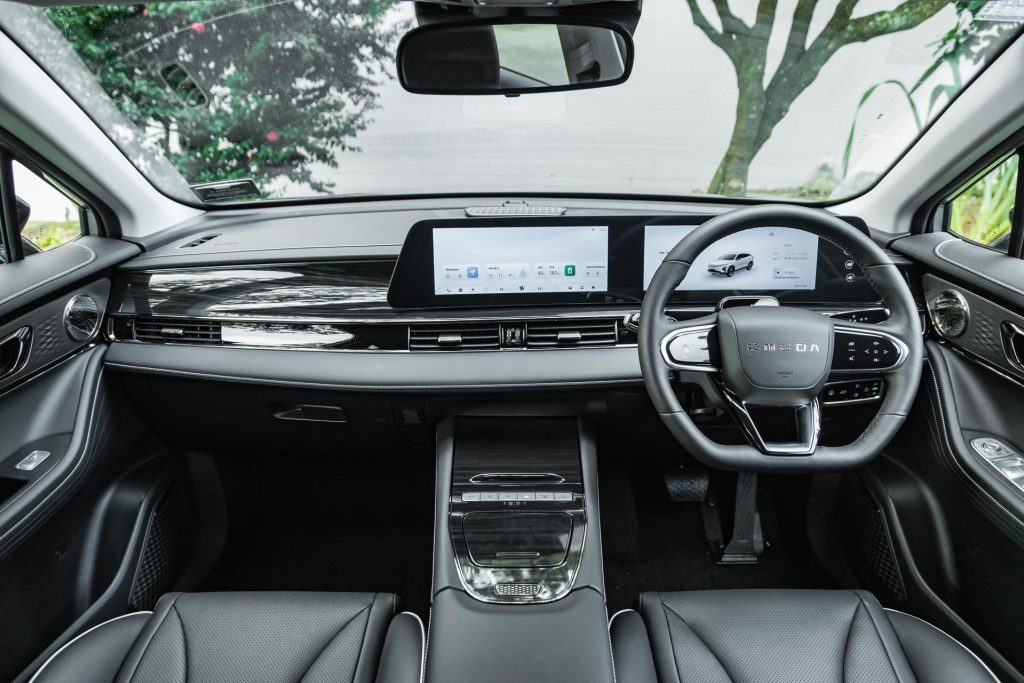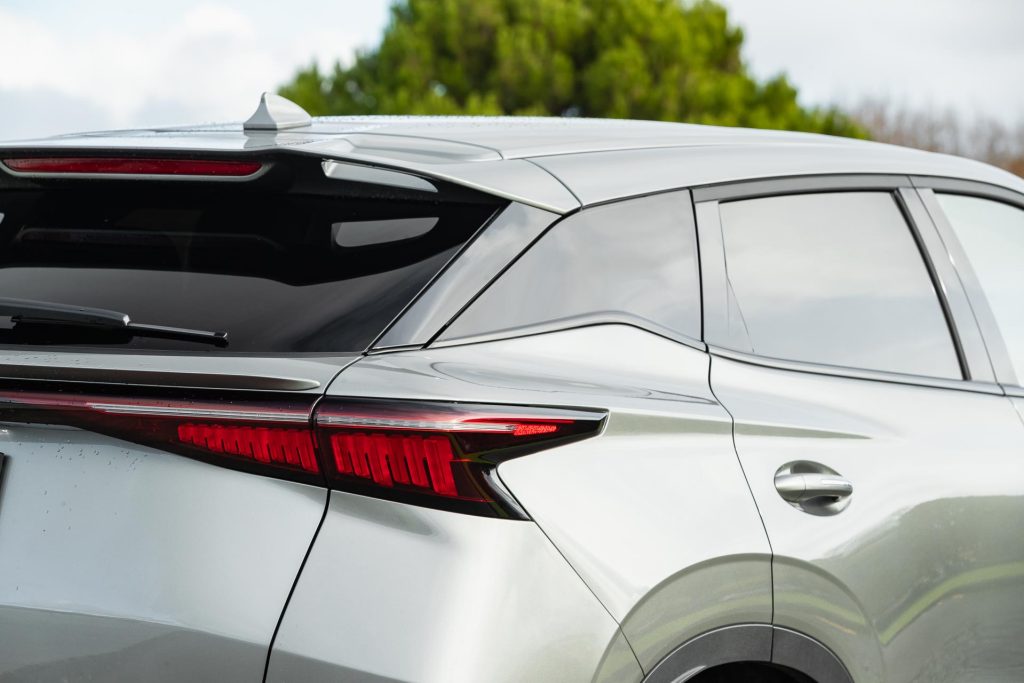2024 Omoda E5 EX review
Words: Peter Louisson | Photos: Isaac Western
There’s a new baseline for EV crossover value in New Zealand and you’re looking at it, the Omoda E5. Is it a step up on its rivals?
While the brakes may be going on sales of electric vehicles across the globe, here in New Zealand the slowdown mainly stems from the removal of the government’s Clean Car Discount.
New EV road-user charges added insult to injury. A double whammy then but don’t worry because the government has promised to install 10,000 new public chargers in its first term. Wonder how that’s going?

Meantime, things locally haven’t been helped by the great EV global slowdown.
Unfortunately for newcomer Omoda, the launch timing of its first fully electric model here, the E5, couldn’t have been much worse.
But it is what it is; the brand had committed at least a year before the gloss started to wear off the EV revolution.

And on the upside, this takes over the mantle of the least expensive electric crossover on the market. Not the one you see however, which is the higher grade EX variant.
But the BX model kicks off at $47,990, undercutting MG’s ZX EV at $50,990 and the $55,990 BYD Atto 3. Mention of, the Omoda uses an LFP ‘Blade’ battery pack sourced from the same company.
EX variant adds spec only
As mentioned, the E5 comes in two variants, the base Omoda E5 BX and this better specified example, the EX. Pick the more expensive offering ($54,990) by its rear privacy glass, and powered sunroof and tailgate.
Less obvious, at least from the outside, are powered, heated and ventilated front seats, 64-colour ambient lighting and a 360-degree surround monitor. In all other ways they are the same.

The vehicle itself is similar in many ways to the Omoda C5, the ICE powered newcomer that kicked things off for Omoda. Well, in appearance at least. You’ll notice the E5 lacks a grille up front.
In place of that, beneath the Omoda badging, is a little charging hatch. That makes home charging easy if you have a wall box directly in front of where the car parks in the garage.
It also eliminates any unsightly charging port slots on the side of the vehicle.

Fine lines
And indeed this is an attractive offering, in that practical windswept crossover style. Omoda describes it as compact but at 4424mm in length, it feels slightly bigger than that.
And if you climb into the back seat area there’s quite reasonable knee room, and also headroom despite the fitting of a sunroof. A flat floor makes things easier for three, while a couple of charge points will at least keep two rear seat occupants happy.
Up front the E5 is pretty much your stereotypical modern EV, buttons a rarity, the touchscreen controlling most functions. An all-seeing eye pointing directly at you aims to limit distraction (driver monitoring system).

Which, of course, it cannot do, despite activating quite regularly. It bleeps once to inform you that you have been “distracted for a long time”. That’s despite your eyes often being fixed on the road ahead.
And at other times it quite rightly admonishes you for being distracted. Distraction is what happens when everything devolves to a central touchscreen. So if you want to change stations or temperature you should pull over to do that.
Or ask the hired help (voice control). While the distraction alert goes off a fair bit, it’s not as annoying as some others we’ve encountered lately. And the rebuke is mercifully brief.

We found the touchscreen glitchy on occasion which I guess happens with first-generation offerings. Sometimes when you hit the home screen ‘button’, it unexpectedly goes instead to the climate control option.
The screen is a bit all over the show too. Regeneration settings are under the “New Energy” banner and within one of the submenus there.
But honestly, if you can’t change it quickly and easily (preferably by paddles) then you just won’t, will you? We left it on the base (low) setting where it worked well enough.
Even the high level of regen is a little shy of single-pedeal driving. When you have only 100km of range left, it offers an Eco+ setting which ramps up regen to high levels.

Moderate range
This features three drive modes. The E5 goes well even in the Eco setting, though is a bit perkier in the Normal and Sport alternatives. With some EVs the Eco setting is like driving with the handbrake on.
Not here; it feels fine in town and out, such that we seldom used any other. Does it save on energy use? I guess so but it seemed to use about 30 per cent of battery capacity driving 106km so that’s a range of about 350km.

However, virtually all of that was on roads with 80-100km/h speed limits and it’s a 61kWh pack (60.4 usable).
The 430km WLTP claim will always be a best-case scenario but certainly in town energy use is more modest. On the Omoda website you can check range depending on how much town vs country running you do.
It suggests around 330km when it’s all done at highway speeds, 430km in town. Overall consumption is rated at 15.9kWh/100km.

This vehicle doesn’t come with an emergency charger but we have one and hooked it up whenever the vehicle was lying idle.
After an overnight charge (8pm until 8am) the charger had fed 22.4kWh into the battery, taking it from just under 40 to 70 per cent (adding 130km of range to 270 remaining).
You can hook up to an 80kW fast charger and a 10-80 per cent reboot is said take the 30min. This costs more than charging at home however.

Zippy performance
Under the hood is a 150kW/340Nm motor that drives the front wheels. Stick it in Sport and it will make haste to 100km/h in a tich over seven seconds (claim 7.2/7.6sec, depending on what you read).
Beware giving it the berries off the mark in the wet; it will more than just chirp the front tyres. Acceleration to open road speeds is fully two seconds quicker than with the C5 1.5T we drove in January. It’s also faster than the Atto 3 and MG opposition.

Where the C5 EX goes for $34,990 this E5 EX costs exactly $20k more. An AWD 1.6 C5 sells for $39,990 while the BX variant of the EV has a $47,990 sticker, cutting the cost difference to $8k.
So it’s nice to have the choice of two similarly powered but differently specified models.
Inside, there’s an overhead sunroof in the EX, a solid roof in the BX. We felt the window lift controls were a direct copy of any modern Mercedes. So too the loudspeaker grilles, though these are made of plastic where those of the Burmester are covered in metal items.

We found the driving position just a little odd; the seats delve down far enough but the wheel needs to be raised a bit more than we’re used to so you can see the screen in its entirety.
At this point the wheel feels a bit odd, laid over like that in a bus. The other detraction is a lack of adjustable lumbar support, of any kind. Pity because otherwise it’s quite pleasant in the cabin.
And the drive itself? Quite decent really, and it points well in that weight balanced EV way.

It’s not quite as soft as the BYD Atto 3 or MG meaning better body control in corners without the ride being too firm.
We rather liked that you can adjust brake pedal intensity too, while also limiting dive under braking. The one area where the others might gain a small advantage is luggage capacity, rated at 380-1075L.
Its 440 for the BYD, and 470 for the MG. There’s no frunk to speak of.

On the safety front this has more driver assistance aids than you can shake a stick at. The C5 gained a five-star ANCAP rating so we imagine this will do the same.
And on the peace of mind front, there’s a seven-year unlimited km warranty.

So yes, E5 is certainly competitive. And we imagine any of the niggly first-generation touchscreen issues can be sorted by OTA updates.
| Model | Omoda E5 EX |
| Price | $54,990 |
| Motor | 150kW, 340Nm |
| Battery | 60.4kWh net |
| Range | 430km |
| Drivetrain | single-speed auto, FWD |
| Energy Use | 15.9kWh/100km |
| C02 Output | 0g/km |
| 0-100km/h | 7.02sec |
| 80-120km/h | 4.69sec (133.6m) |
| 100-0km/h | 36.11m |
| Stability systems | ABS, ESP |
| Safety | AEB, ACC, BSM, LDW, RCTA, ALK, AHB |
| Luggage capacity | f-9L r-380-1075L |
| Tow rating | Not rated to tow |
| Turning Circle | 10.2m |
| Warranty | 7yrs, unlimited km |
| ANCAP rating | Not yet rated |
| Weight | 1710kg (claimed) |
This story first appeared in the July 2024 issue of NZ Autocar magazine.





